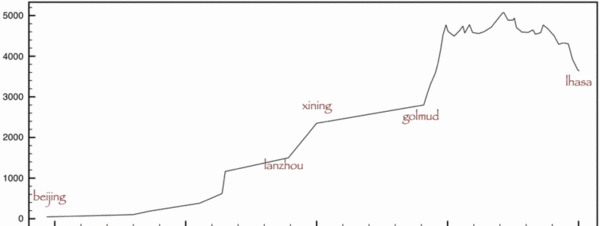In 2004 the world started to become aware that the the ralway to Lhasa indded was becoming a fact. The near-completion started a chain of reactions : in some Chinese netizens it became an object of national pride (some would say chauvinism) , and among others it was seen as one more nail in the coffin containing Tibetan culture. The Wikipedia article soon became a battle ground along predictable lines , starting with What is Tibet , anyway ?
world started to become aware that the the ralway to Lhasa indded was becoming a fact. The near-completion started a chain of reactions : in some Chinese netizens it became an object of national pride (some would say chauvinism) , and among others it was seen as one more nail in the coffin containing Tibetan culture. The Wikipedia article soon became a battle ground along predictable lines , starting with What is Tibet , anyway ?
In the media , a lot of attention was centered on the engineering challenges of worlds highest railway , running over 5000 meters high , and the brand new , shiny thing : the worlds first train with a pressure cabin . Everyone – the BBC, Guardian etc went aah .. – so did I .
The one question that would have blown this story to bits was never asked : so what happens when we pop off for a nice cup of tea in the restaurant car that looks so nice ? No air locks ..
The pressure cabin myth has acquired a life on it´s own : you still hear of people boarding the train with that thought , being awakened by the sound of hard drives going clunk! . Bye , bye , iPod.
What eventually materialised was a train with oxygen generators , spiking the atmosphere up to 23-24 percent (according to the latest issue of High Altitude Medicine), and nasal cannulas with low (undefined ) flow of pure oxygen.
Oxygen enrichment was not a new concept , it has been used in high altitude observatories up to 5000+ meters for a number of years , but the train solution is obviously a compromise between comfort/safety and economy : the observatories run by Caltech University use for example 24 % in their observatory at 3800 meters , and 27 % in their highest facility the Cosmic Background Imager at (corrected for difference in air pressure) around 4800 meters , very close to the long high run of the Tibet train.
So how does these numbers work out ? Well , in the context of travelling to Lhasa : surprisingly well . Assuming these figures are correct , you will breathe the same effective oxygen concentration at 4500 meters as in Lhasa – with the added benefit of having access to the supplemental oxygen by nasal cannulas.
This is if everything works as stated – I would expect the whole car dropping down to 21 % more or less immediately every time people get off the train, for one thing .
Not worse than flying in , with a very limited advantage in the time spent before Golmud . Basically the first twenty or so hours on the train is a dead loss , acclimatisation wise , you need to reach something like 2000 meters to start effective acclimatisation. If your motivation to take the train is to be gentle on your system , you will profit a lot more by flying in to Xining , and take train the next day . Golmud would be even better , at 2800 meters , but by all reports it´s harder to arrange your travel onwards from there.
Minimising your time in Beijing , if you have flown in , will also a give a subtle advantage , tying together the time at cabin pressure (2100 meters, at best ) with the second half of the track.

A poster in another thread has called to my attention (thanks , zhaoyun) that the elevation profile between Xining and Golmud is inaccurate: after Xining the track ascends to 3000+ around the Koko Nor lake , then descends to Golmud (2800, as already shown) . I´ll get some more elevation data and update later.
very interesting.
i’m adding in RSS Reader
Thanks for information.
many interesting things
Celpjefscylc
Hey, may I know what is the cost for the train ticket and how did u book it? Thanks
You can look up the current list price from the man in seat 61 ( seat61.com) , but this is in theory only : all travel to Tibet is via travel agents , group only since March 2008.
Brilliant posts!
I’m taking a train to lhasa next week and was wondering what were your thoughts on taking Diamox for the train ride? – is it worth it?
50% suggest to take it and 50% suggest not to??. But then again, if the train is pumped with oxygen and you never really get to experience the 5,000m altitude hike, then it might be better not to?
Thanks!
Pumped full of oxygen is stretchingg the point a bit , we are still talking about the same altitude as Lhasa : still a respectable altitude . The oxygen generators start after leaving Golmud and will need some time to build up the concentration.
My first choice would be to have a layover in Xining , not only for the physiological effects , this is on the outer border of the Tibetan cultural sphere.
With a single night there I would go for the normal dose of Diamox , with two or more nights the lower , evening only dose that helps prevent periodic sleep disorder.
The first hours from Golmud you go up to 5000 meters at the same time as the oxygen generators are building up the concentration in the carriages – I´d use the oxygen outlets liberally in this restricted period, without being chained to them.